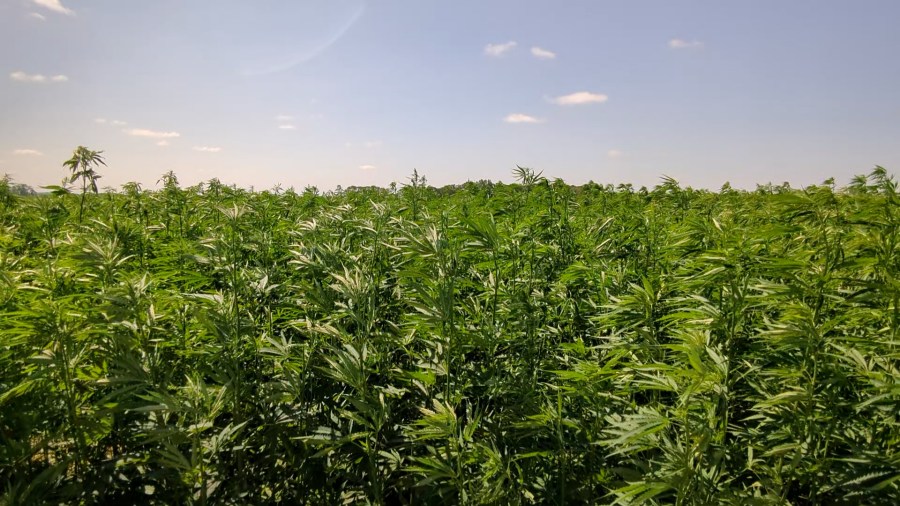WAKONDA, S.D. (KELO) — South Dakota’s burgeoning hemp industry — now in its 4th growing season — offers the promise of a wide variety of applications and products supplied by a truly home-grown source.
When we look at hemp production, the most visible components are the actual cultivation of the plant and the retail applications. You can look at a field of hemp plants waving in the breeze, and you can put your hands on products such as hemp fabrics, CBD gummies or even hemp-based insulation.
Hemp grower, John Peterson of Dakota Hemp in Wakonda, provided an example of one of these applications, describing a variety of hemp he grows that is desirable for textile manufacturers.
“Well this variety here is FIBROR 79,” said Peterson, walking among the crop. “In the last few weeks, it’s started to turn yellow at the bottom. As this plant matures, it’ll start to turn yellow way up to the top, and that’s good for the textile industries as far as dying the fabric.”
Karll Lecher is the COO for Peterson’s hemp operation, and he gave some info on another product from hemp — CBD.
“We grow about two acres each year for CBD; about 1,500 plants,” said Lecher. “It’s just enough that we can send it out for extraction and make products for our product line.”
Lecher listed off some applications for CBD; pain management and inflammation, but noted that they do not advertise it for these uses due to current FDA restrictions.
“Really, our big thing is we just try to get people to try it,” Lecher said of the CBD.
Lecher also explained the process for harvesting CBD.
“The flower itself has a trichome that grows off of it — like a gooey, milky crystal,” explained Lecher. “We monitor those trichomes and wait for them to turn amber.”
Once the trichomes turn to an amber color, they are then at their highest content of cannabinoids.
“At that point, we’ll harvest it, we’ll dry it and we send it off for extraction,” said Lecher.
Once the CBD is extracted, it can be added to products such as relief creams, hand creams, roll-ons and tinctures, said Lecher.
Beyond CBD, Peterson says most of their growing is for the purpose of grain and fiber. “It’s going to be a more widely grown crop for large-acre farmers in South Dakota,” predicted Peterson.
While the product Peterson named above is good for textile purposes, that’s not all it’s used for.
“This variety we’re growing for what we call a fiber stalk,” said Peterson, explaining that they are growing it specifically for its stalk. “This will be turned to animal bedding, hempcrete (a hemp-based building material used for insulation and other applications) — insulation replacement and paper products, just to name a few.”
The market for hemp is indeed wide — Lecher mentioned he’s heard of people working on a way to produce ethanol from hemp stalks — but while production and demand are growing, a bottleneck looms.
Between the process of cultivation and the end products on shelves, the harvested hemp must be processed.
This is where the bottleneck forms. There is currently only one hemp processing facility in the state of South Dakota, run by South Dakota Industrial Hemp Association President Ken Meyer, who estimates that there are only around 20 across the entire nation.
Prior to Meyer’s facility coming online, Peterson had mentioned that farmers in South Dakota had to transport hemp bales to Montana or Kansas for processing.
“We have to get more processing for hemp available in the state so that the farmers continue to have a current and expanding markets for their hemp crops,” said Meyer on the subject. “There are different hemp products that are being prototyped and coming to market. Each one of those will require hundreds of thousands of acres of hemp to support those products.”
In addition to their cultivation operations, Dakota Hemp is also in the process of building their own processing facility, something they hope will help to alleviate the bottleneck.
While this will help, Peterson makes it clear more will be needed. “Processing capacity will now be the bottleneck for further expansion in the state, and more dollars are needed to go into that effort,” he said, urging people with an interest in the field to contact the Industrial Hemp Association. “More investments are needed to expand our processing capacity in the state to further expand our grower network of farmers.”


